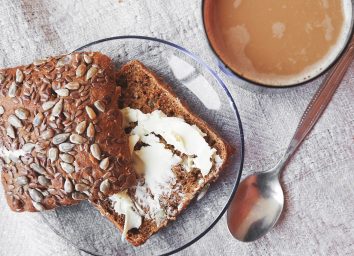What Does It Mean To Be Fat Protein Efficient?

Ever wonder why Karen goes keto and drops mad weight within the first two weeks, while you feel like a greasy sloth on the high-fat, low-carb diet? Some experts say it could be because Karen is fat protein efficient while you are not.
Never heard the term fat protein efficient before? Even folks who are most up-to-date on all the weight loss and wellness trends haven’t. Fat protein efficiency is connected to the metabolic typing diet—an approach to eating that accounts for individual differences in digesting different food groups.
Learn what the metabolic typing diet is, what it means to be fat protein efficient, carbohydrate efficient, or mixed, and how learning your metabolic type may help support your overall health and wellness goals.
What is the Metabolic Typing Diet, exactly?
First created in the 1930s by Weston Price, the metabolic typing diet relies on the belief that everyone’s digestive system metabolizes the different macronutrients (protein, carbohydrates, and fat) differently based on things like genetic make-up, body type, lifestyle, and the reactivity of their parasympathetic and sympathetic nervous system.
Registered dietician Amanda A. Kostro Miller, RD, LDN with Smart Healthy Living explains: The hypothesis is that once you learn what your metabolic type is (according to this diet, there are three), you can adjust your macronutrient intake accordingly. The idea is that this allows you to maximize your overall health and wellbeing—and lose weight, if that’s your goal.
The three metabolic types
We’ve already established that fat protein efficient is one of the metabolic types (hi Karen!), but there are two others: carbohydrate efficient and mixed. Let’s dive in.
Someone who’s fat protein efficient metabolizes (read: digests and turns to energy) protein and fat more efficiently than they do carbohydrates. Sometimes called “fat oxidizers” or “parasympathetic dominant”, folks with this type of a metabolism love salty, fatty snacks; graze all day long; and tend to fail on lower-calorie diets. The metabolic type diet says that a high protein, high fat, low carbohydrate diet can help these individuals maximize their overall wellbeing and drop weight.
For those who are carbohydrate efficient, the opposite is true. Their body digests carbohydrates much more efficiently than it digests protein or fat. These folks (sometimes called “slow oxidizers” or “sympathetic dominant”) often have smaller appetites, love sweets, and have fluctuating weights, explains Lisa Richards CNC, nutritionist and founder of The Candida Diet. The metabolic typing diet instructs that eating more carbohydrates and a lower amount of fat and protein can help them get rid of stubborn weight, as well as reduce mood fluctuations.
Lastly, those who are in the ‘mixed’ group, digest all the major macronutrients equally as efficiently. According to Richards, they generally have average appetites, crave sweet and salty foods equally, and don’t struggle with their weight. A diet with equal amounts of the three macronutrients is thought to help them have sustained energy all day long, and optimize their overall wellbeing.
Finding your metabolic type
At this point, there’s no official testing that can be done to tell your metabolic type. “The only way to know your metabolic type is to take a test where you answer a series of questions regarding your eating habits, mood, cravings, and more” says Richards. The most popular test can be found in researcher William Wolcott and Trish Fahey’s book The Metabolic Typing Diet. (Pro tip: Buy the Kindle version of the book for just $14.99, then fill out the free PDF version of the test that comes with it).
Another option: Work with a nutritionist or a healthcare practitioner. They will ask you similar questions as the self-assessment test would, such as what your ideal breakfast is, how often you eat each day, and what foods give you energy versus sapping it. But they’ll also be able to suggest additional blood or urine testing that may be helpful.
What to eat on a Metabolic Typing Diet
That depends on your metabolic type. “The prescribed macronutrient breakdown for folks who are fat protein efficient is 30 percent calories come from carbohydrates, 30 percent from fat, and 40 from protein,” says Richards. “For folks who are carbohydrate efficient it’s 60 percent calories from carbs, 15 percent from fat and 25 percent from protein.” For folks who are mixed, generally the recommendation is to get an equal ratio of all three macronutrients, she says.
Beyond differences in macros ratio for each group, the recommended foods within each macronutrient category are different, too. For instance, protein fat efficient types need a diet that is rich in high-fat, high-purine proteins such as pâté, beef liver, chicken liver, beef, bacon, anchovies, and caviar. Protein fat efficient types are also encouraged to eat high-fat foods like whole fat milk, cheese, cream, eggs, and yogurt. When eating carbohydrates, the metabolic type diet recommends that these folks eat lower-starch carbs such as whole grains, asparagus, beans, cauliflower, celery, avocados, and olives.
Carbohydrate efficient types, on the flip side, are encouraged to avoid high-fat, high-purine proteins and opt for lower-fat, low-purine proteins like chicken breast, Cornish game hen, turkey breast, and pork. And rather than having to restrict carbohydrate intake, carbohydrate efficient types are allowed to eat starchy and non-starchy vegetables. This type is encouraged to limit legume, dairy, and oil intake.
While there is some variation among those who are categorized as mixed types, you can think of this group as the best of both worlds. That means that they need a good balance of high-purine, high-fat proteins and low-purine, low-fat proteins. Likewise, they need to get a mix of the fruits and veggies that are good for each of the other types.
What’s the benefit of eating for your metabolic type?
The main benefit is that this approach is more individualized than, say, the keto diet or the South Beach diet, which recommend the same macronutrient breakdown for every single person. And, as Richards says, “Any eating plan that is tailored towards your body’s particular strengths and weaknesses has a higher probability of being effective.”
Furthermore, the metabolic typing diet has a few basic principles that apply to everyone. One of them? Limit refined carbohydrate intake. Unlike whole grain carbohydrates which are full of fiber, vitamins, and minerals, refined carbohydrates are derived from grains that have been completely stripped of many of these nutrients during processing.
Generally, refined carbohydrates (white bread, cookies, crackers, white pasta) are full of blood-sugar spiking sugars, low in fiber, and deny you the opportunity to get necessary nutrients, explains registered dietician Bonnie Taub-Dix, RDN, creator of BetterThanDieting, and author of Read It Before You Eat It. “Because they don’t keep you full for very long, you end up eating more food because you get hungry more quickly,” she says.
“Limiting refined carbohydrate intake and prioritizing whole grain carbohydrates like oatmeal, quinoa, bulgur, and buckwheat instead, is generally very good advice for people who are trying to lose weight—or just be healthy,” says Taub-Dix.
All types are also encouraged to avoid alcohol, caffeine, and sugar with the reasoning that in significant quantities these things are not good for anyone, no matter the metabolic type.
Are there any cons to eating for your metabolic type?
You bet! For starters, according to Taub-Dix, the metabolic type diet is not a balanced diet—no matter your type. “A balanced macronutrient breakdown usually means that you’re getting 45 to 55 percent of your calories from carbs, 25 to 30 percent from fats and 20 to 25 percent from protein,” she says. And as you’ll remember from the previous section, these ratios are *not* the recommendation for any of the three metabolic types.
According to Taub-Dix, a diet with a more balanced macronutrient breakdown is the best way to achieve weight loss, as well as sustain it over many months and years. “Eating a well-balanced diet ensures that you’re not over-restricting any one food group,” she says. “Often, less balanced diets are followed by binge phases filled with over-eating.”
Another issue, according to Miller, is that while there are three different metabolic types, metabolic typing is still a far less individualized approach to weight loss than most folks need. “Our metabolism and ability to lose weight is affected by many things like gut health, presence/absence of good gut bacteria, genetics, body composition, chronic conditions (fat malabsorption, liver integrity, IBS), presence of other nutrients at the time of absorption, medications, and more” she says. “The metabolic typing diet leaves out so many of these factors.”
According to her, if an individualized diet is what you’re after, your best bet would be to skip the metabolic diet completely and work with a nutritionist instead.
The bottom line on the Metabolic Typing Diet
Overall, the metabolic typing diet has some rules that nutritionists say can be helpful for weight loss and improved health. But all-in-all, our nutritionists were not fans. As Miller says, “If you’re considering a more individualized eating plan, working with a nutritionist who can take your exercise habits, food preferences, genes, and more into account is a much better option.”
Taub-Dix says, “While cutting refined carbs, sugar, and alcohol is a good move, I see no reasons to be altering your macros to this extent.”








